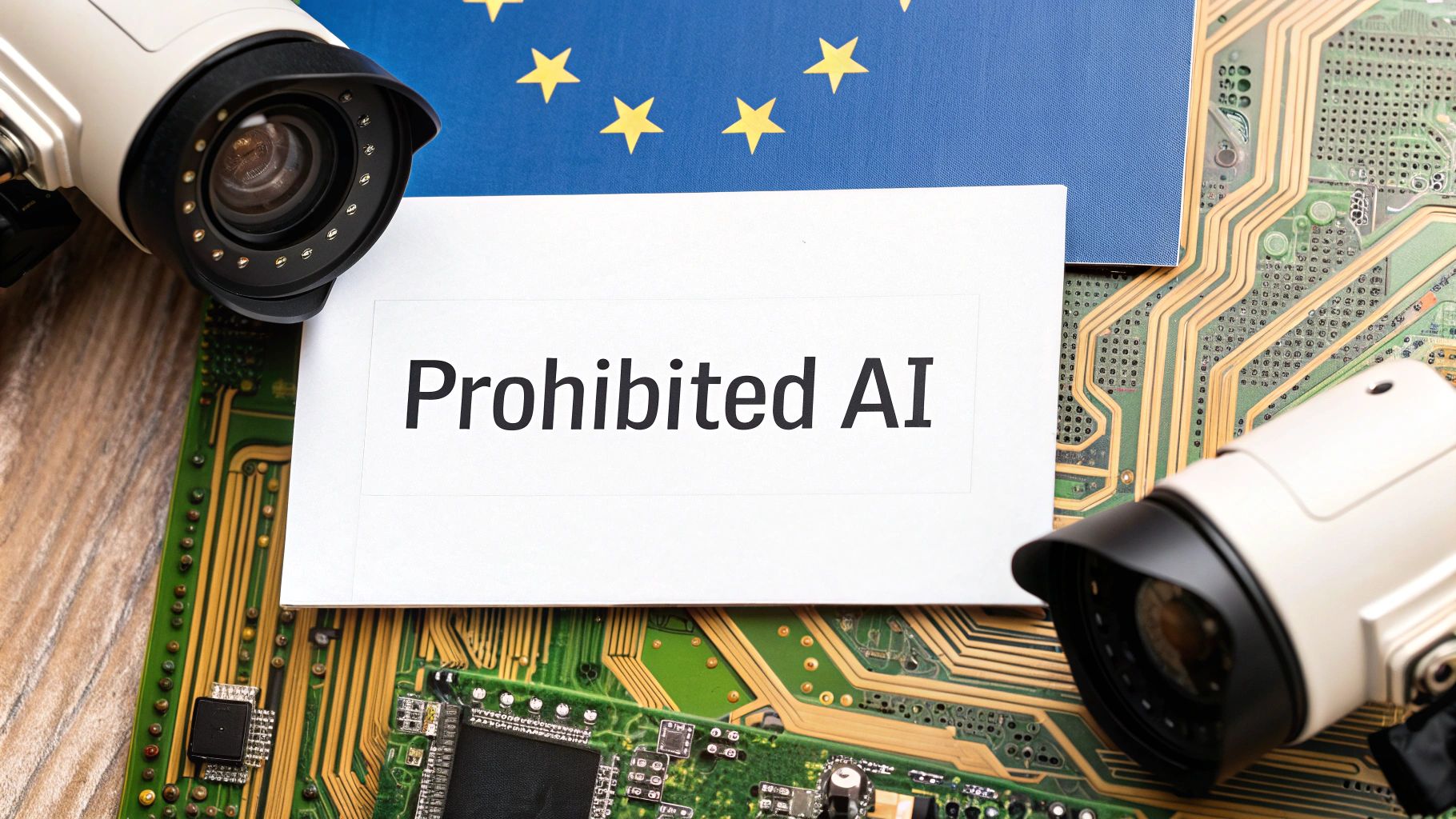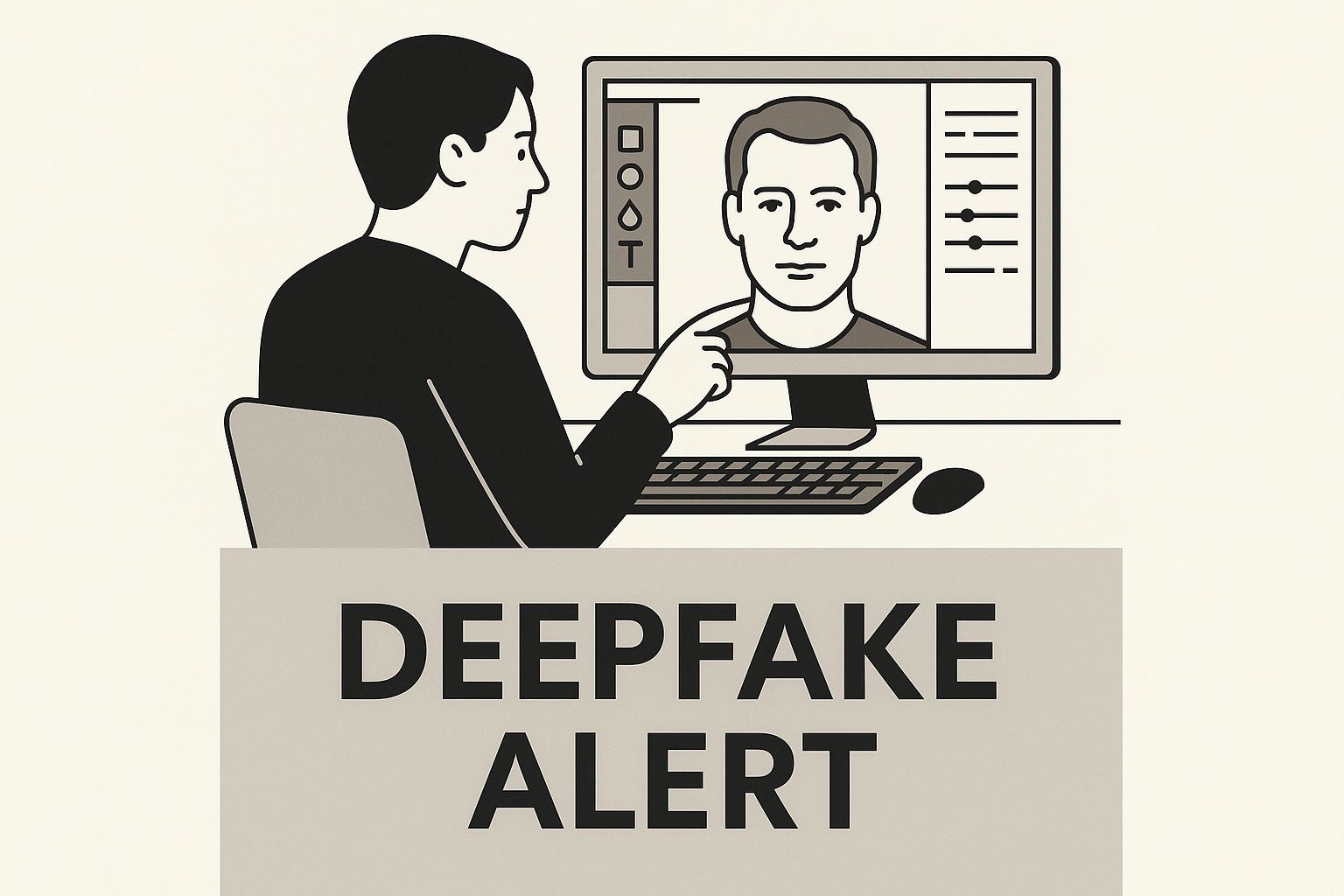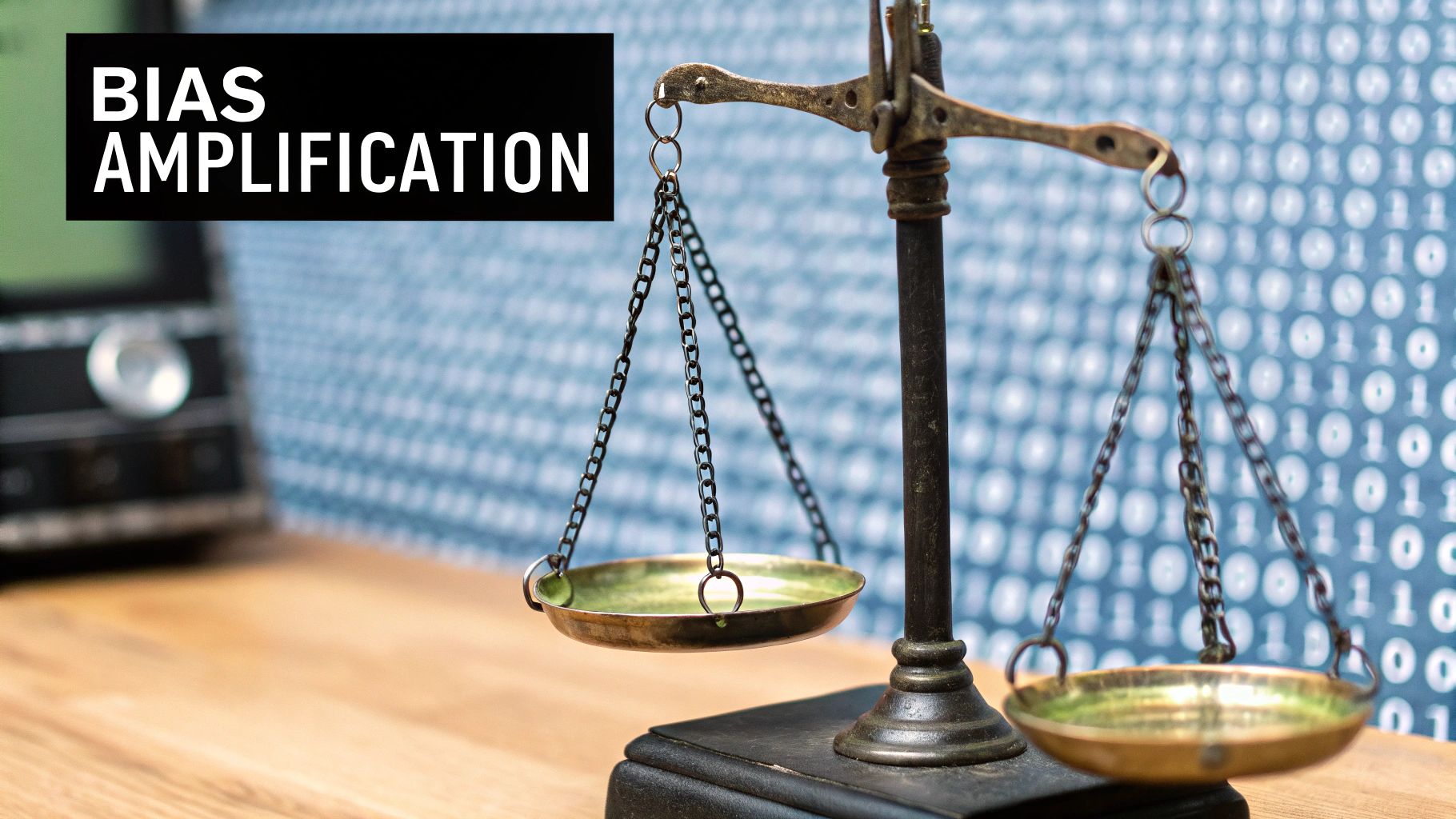
Prohibited AI Practices: A Guide to the EU AI Act's Unacceptable Risks
Under the EU AI Act, some AI applications are considered so dangerous to fundamental rights, safety, and democracy that they are banned entirely. These prohibited AI practices represent an "unacceptable risk," meaning no amount of regulatory oversight or technical safeguards can justify their use in the European Union. They are banned outright.
Drawing a Line in the Sand: The Concept of Unacceptable Risk
The EU AI Act is not a blanket ban on artificial intelligence. It is a risk-based legal framework that categorizes AI systems according to their potential for harm, creating a regulatory pyramid.
At the very top of this pyramid are the AI practices deemed completely forbidden. These are systems that pose an ‘unacceptable risk’ to society. The line here is clear and firm. The EU has determined that AI designed to maliciously manipulate human behavior, exploit vulnerabilities, or enable mass surveillance and social scoring poses a fundamental threat to the Union's core values and is too dangerous to permit.

A Quick Look at the AI Risk Pyramid
Understanding the EU AI Act's structure is key. It's built on four distinct risk levels, which helps focus regulatory attention where it's needed most.
- Unacceptable Risk: This is the peak of the pyramid, covering the prohibited practices we're discussing here. These systems are simply not allowed in the EU.
- High Risk: This tier includes AI used in critical areas like medical devices, hiring, or law enforcement. These are allowed, but they must comply with a long list of strict requirements before being placed on the market or put into service.
- Limited Risk: Think of systems like chatbots. The main rule here is transparency—providers and deployers must ensure users are aware they are interacting with an AI system.
- Minimal Risk: This is the base of the pyramid and covers most AI applications, like spam filters or video game AI. These face few, if any, new regulations under the Act.
For any organization developing, providing, or deploying AI, the first step toward compliance is to classify its systems according to this risk pyramid. For a deeper dive into all the tiers, our EU Artificial Intelligence Act summary breaks everything down.
The purpose of banning certain AI practices is to safeguard human dignity, freedom, and fundamental rights. The EU AI Act aims to prevent dystopian scenarios—like government-run social scoring or subliminal manipulation—to protect the foundations of a democratic society. It’s a landmark regulation that sets a global standard for putting people before technology.
The Four Categories of Banned AI Systems
To fully grasp the EU AI Act, it's essential to look at what has actually been banned. The Act does not vaguely prohibit "bad AI"; it targets very specific, unacceptable risks by grouping prohibited AI practices into four distinct categories. These prohibitions are designed to protect human dignity, autonomy, and fairness.
Let's break down each category with real-world examples to understand the practical implications of these bans.
Manipulative or Deceptive AI Systems
The first category bans AI systems that use subliminal, manipulative, or deceptive techniques to distort a person's behavior in a way that is likely to cause them or another person physical or psychological harm.
A classic example would be an AI-powered toy that uses voice commands to encourage a child to perform a dangerous act. Another could be a social media algorithm that intentionally exploits a user's cognitive biases to push them toward extremist content or self-harming behaviors.
The core principle here is protecting our freedom to make informed choices. If an AI operates "beyond a person's consciousness" to materially distort their behavior, it crosses a fundamental ethical and legal line and is strictly forbidden.
This infographic captures the essence of this concern, showing how technologies like deepfakes can be weaponized for manipulative purposes.

The image highlights how easily AI can create deceptive content, underscoring why regulators are so focused on preventing systems that manipulate or impersonate people without their knowledge.
Exploitation of Vulnerabilities
The second category is closely related to the first but specifically targets AI that exploits the vulnerabilities of a person or a specific group. The law recognizes that some individuals—due to their age, disability, or social or economic situation—are more susceptible to being manipulated.
For instance, an AI system that identifies individuals with a gambling addiction and then targets them with advertisements for online betting sites would be banned. Similarly, a loan application that uses AI to target financially desperate individuals with predatory offers containing crippling hidden terms would be prohibited.
The law is clear: it’s about establishing a protective shield for those who may not be able to resist such calculated influence.
Government-Led Social Scoring
This prohibition, which sounds like something from science fiction, is designed to keep such scenarios fictional. The EU AI Act bans AI systems used by public authorities for the purpose of social scoring. This prevents governments from evaluating or classifying the trustworthiness of citizens based on their social behavior, personal characteristics, or expressed opinions.
If this were allowed, a person's access to public benefits, loans, or even housing could be denied based on an opaque AI-generated score. The Act puts a firm stop to this, preventing the emergence of a surveillance state where individuals are judged and penalized by algorithms. You can learn more about how different AI systems are classified based on their risk level in our detailed guide.
Real-Time Remote Biometric Identification
Finally, we have one of the most debated prohibitions: a general ban on the use of real-time remote biometric identification systems (like live facial recognition) in publicly accessible spaces for law enforcement purposes. This is a direct measure to prevent mass surveillance and protect the fundamental right to anonymity.
The ban is strong but not absolute. It includes a handful of narrowly defined and strictly regulated exceptions for grave situations, such as searching for a missing child or preventing an imminent terrorist attack. Even in these cases, law enforcement must obtain prior judicial authorization. The default position, however, is a clear "no."
To help you keep these categories straight, here is a quick summary of the prohibited AI practices.
Prohibited AI Practices at a Glance
This table breaks down the four main categories of AI systems that are completely off-limits under the EU AI Act.
| Prohibited Practice Category | Core Prohibition | Real-World Example Scenario |
|---|---|---|
| Manipulative or Deceptive AI | Using subliminal or deceptive techniques to distort behavior in a harmful way. | An app that subtly encourages users with eating disorders to engage in unhealthy behaviors. |
| Exploitation of Vulnerabilities | Targeting the specific vulnerabilities of a person or group to cause harm. | A system that targets financially distressed individuals with high-interest predatory loan ads. |
| Social Scoring by Governments | Evaluating or classifying people based on their social behavior, leading to detrimental treatment. | A city algorithm that lowers a citizen's "trust score" for attending a protest, affecting their access to public services. |
| Real-Time Biometric ID | Using live facial recognition or other biometrics in public spaces for law enforcement. | Police deploying live facial recognition across a city to identify anyone with an outstanding fine. |
These prohibitions form the bedrock of the AI Act, setting firm boundaries to ensure technology serves humanity, not the other way around.
Why These Specific AI Systems Are Banned

The EU’s decision to ban certain AI systems was a deliberate effort to defend core European values. Each of the prohibited AI practices was outlawed because it poses a direct threat to fundamental rights like human dignity, privacy, and non-discrimination. Viewing the AI Act as a mere compliance checklist misses its profound purpose.
The entire framework operates on a powerful premise: some technologies are fundamentally incompatible with a free and democratic society. They cross a line where the potential for harm is so severe that no amount of regulation could make them safe. It’s a proactive move to ensure dystopian scenarios remain in the realm of fiction.
Protecting Human Autonomy
A central pillar of the ban is the protection of human autonomy—the fundamental right to make one's own choices without being covertly manipulated. Certain AI systems are designed to undermine this very principle.
Consider an AI that uses subliminal messages, too fast for conscious detection, to influence purchasing decisions or even voting behavior. This is not persuasion; it is subversion. It bypasses a person's critical faculties and consent, effectively making them a puppet controlled by an algorithm.
This is precisely why the Act bans systems that use “subliminal techniques beyond a person’s consciousness.” The goal is to ensure technology augments human decision-making, not hijacks it.
Defending Human Dignity and Equality
Another core value at stake is human dignity—the intrinsic worth of every individual. AI that exploits people's vulnerabilities is a direct assault on this idea.
The law specifically prohibits scenarios like these: * Targeting Vulnerable Groups: Imagine an AI that singles out people with a documented gambling addiction and floods them with online casino ads. * Exploiting Desperation: Picture a system that scours social media for signs of financial hardship and then targets those individuals with predatory loan offers full of hidden fees.
These practices are outlawed because they reduce people to mere data points to be exploited. The Act draws a clear line: an algorithm cannot be allowed to prey on human weakness for profit or control.
The ban on government-led social scoring extends this protection to a societal scale. It prevents a future where citizens are constantly monitored and rated by an opaque AI, and their "trust score" determines their access to public services. This is a crucial safeguard against algorithmic control that would shatter equality.
By prohibiting these specific AI applications, the EU AI Act does more than just regulate technology. It lays the foundation for a digital world where fundamental rights and ethics guide innovation, ensuring that AI serves humanity.
The Global Reach of the EU AI Act
Many companies outside of Europe mistakenly believe the EU AI Act does not apply to them. This is a critical and potentially costly error. The Act has significant extraterritorial reach, a phenomenon often called the "Brussels Effect," where EU regulations effectively set global standards.
The principle is straightforward: if your AI system is placed on the market or put into service within the European Union, you must comply. It does not matter if your company is headquartered in Silicon Valley, Toronto, or Tokyo. The location of your servers or developers is irrelevant; what matters is the location of your users.
This reality makes ignoring the list of prohibited AI practices a major business risk for any company with international ambitions.
Understanding Your Obligations Beyond Borders
Let's consider a practical scenario. An American tech firm develops an AI-powered marketing tool that analyzes user behavior to identify psychological vulnerabilities and trigger impulse purchases.
A German e-commerce company then licenses this software to boost its online sales. Even though the developer is in the US, the moment that AI system is deployed in Germany—an EU member state—it falls under the full jurisdiction of the AI Act. Because the tool is designed to exploit vulnerabilities for financial gain, it constitutes a prohibited practice.
The result? Both the American developer and the German client could face severe penalties.
This is not a new concept. We saw the same global impact with the GDPR on data privacy. The AI Act was intentionally designed with the same international scope to ensure a consistent high level of protection for everyone within the EU.
The key takeaway is this: the EU AI Act is market-based, not territory-based. If your product touches the EU market, you are subject to its rules.
The High Cost of Getting It Wrong
The financial penalties for non-compliance are deliberately severe to ensure companies take their obligations seriously. For deploying a prohibited AI system, the fines are the highest possible under the Act.
The prohibitions take effect six months after the Act enters into force, meaning compliance is an urgent priority. Non-compliance can lead to fines of up to €35 million or 7% of a company’s global annual turnover, whichever is higher. You can discover more insights on the initial prohibitions under the EU AI Act and what they mean for businesses worldwide.
These figures underscore a simple truth: compliance is not just a legal obligation; it is a core business strategy. The potential financial and reputational damage from a violation far outweighs the cost of ensuring compliance from the outset. For any company with a global footprint, understanding the AI Act’s prohibitions is non-negotiable.
A Practical Compliance Checklist for Your Business
Knowing the rules around prohibited AI practices is one thing; putting that knowledge into action is another entirely. For any business with a footprint in the European Union, compliance isn't just a good idea—it's a fundamental part of operating. One wrong move with a banned AI system could cost you dearly, both in fines and in public trust.
To sidestep these risks, you need to build a culture where compliance comes first. That means moving from theory to practice with a clear, actionable game plan. Here’s a straightforward checklist to help you stay on the right side of the EU AI Act's strictest rules.
1. Create a Comprehensive AI Inventory
Let's start with a basic truth: you can't manage what you don't know you have. Your first move should be to create a detailed inventory of every single AI system your organization uses, develops, or is even thinking about buying. Think of it as a living document, not a one-and-done list.
This inventory should track: * The name and purpose of each AI system. * Whether it was built in-house or bought from a vendor. * Which departments or teams actually use it. * The kinds of data it processes and its intended outputs.
This inventory provides the comprehensive visibility needed for the next crucial steps.
2. Conduct a Thorough Risk Audit
With your inventory complete, it's time to audit each system against the EU AI Act's "unacceptable risk" criteria. This audit is your primary line of defense against accidentally deploying a prohibited AI practice.
For every system, ask probing questions: Does it use subliminal techniques? Could it be used to exploit vulnerabilities? Does any feature resemble social scoring? Be meticulous; there is no room for ambiguity when it comes to prohibited practices.
The EU has drawn a clear line in the sand. As of February 2, 2025, several AI practices were officially banned under the EU AI Act, a major moment in tech regulation. The ban covers systems designed to manipulate people, exploit vulnerabilities, score citizens, or use subliminal tricks. These rules apply across all 27 EU member states, and getting it wrong could lead to penalties of up to €35 million or 7% of your global annual turnover. The Act's structure is a lot like GDPR, sorting AI into four risk tiers. You can find more detail on these guidelines on prohibited AI under the EU AI Act on wsgrdataadvisor.com.
3. Establish Robust Internal Governance
Compliance must be woven into your company's DNA, not treated as a mere box-ticking exercise. The key is to build a solid internal governance framework that establishes clear accountability.
Your governance structure should include: * Clear AI Ethics Policies: Draft and communicate a company-wide policy that explicitly forbids the development or use of any prohibited AI systems. * Designated Oversight: Appoint an individual or a committee responsible for AI governance and compliance. * Procurement Protocols: Implement a strict vetting process for any third-party AI tools to confirm their compliance before they are integrated into your workflows.
For a deeper dive, check out our complete guide to AI governance, compliance, and risk.
4. Implement Meticulous Documentation
In the world of regulation, if it isn’t documented, it didn’t happen. Keeping meticulous records is your proof of due diligence. You need to maintain detailed files on your AI inventory, risk audits, and every decision you made along the way.
This documentation is your most critical line of defense. It demonstrates to regulators that you have made a good-faith effort to understand your obligations and have taken concrete steps to comply.
5. Train All Relevant Teams
Finally, remember that compliance is a team sport. Everyone who touches AI in your organization needs to be trained, from the engineers and product managers to the legal and marketing teams. The training should be practical and tailored to their roles. Your developers need to know what they can and can't build, and your procurement team needs to know what to ask vendors. This kind of widespread education turns your entire company into a compliance-aware workforce.
Got Questions About Banned AI? We've Got Answers.
When you start digging into the EU AI Act's rules on prohibited AI practices, a lot of practical questions come up. It's not always immediately clear where the line is drawn between a helpful tool and a system that's completely off-limits. Let's tackle some of the most common questions to get a better sense of how these rules play out in the real world.
The Act is all about preventing serious harm, but the devil is in the details. Let’s walk through a few key scenarios to make these complex rules a bit more concrete.
Is My Smartphone's Face Unlock Banned?
This is a great question, and one I hear all the time. The short answer is no, the face unlock on your personal phone is perfectly fine.
The reason comes down to the crucial difference between authentication and surveillance. When you use your face to unlock your phone, you are initiating a one-to-one verification. You have opted in, and the system is simply confirming that you are who you claim to be. It’s a security feature you control.
The AI Act is targeting something entirely different: real-time remote biometric identification used by law enforcement in publicly accessible spaces. Imagine a network of city cameras actively scanning every face in a crowd to find a match. That is mass surveillance, a "one-to-many" process that erodes anonymity and is fundamentally different from unlocking your personal device.
What if We Accidentally Use a Banned Tool From a Vendor?
Under the EU AI Act, liability is shared across the supply chain. If your company uses a third-party AI tool that falls into a prohibited category, you share the responsibility.
The law assigns obligations to various actors, including providers (who develop the AI) and deployers (who use it). While the provider who created the banned system is certainly liable, so is the deployer—your company. You have a duty to perform due diligence before integrating any third-party AI tool into your operations.
Pleading ignorance will not be a valid defense. Regulators will expect you to have: * Vetted the vendor and their compliance claims. * Conducted your own risk assessment of the tool. * Ensured your specific use case for the tool was not prohibited.
The bottom line is that deploying a banned AI system, knowingly or through negligence, can expose your business to the same severe penalties as the developer—including fines up to a staggering €35 million.
Are There Any Exceptions to These Prohibitions?
Yes, but they are extremely narrow and apply almost exclusively to law enforcement in exceptional circumstances. For commercial use, the prohibitions should be considered absolute.
Take the ban on real-time biometric scanning. The Act includes a few specific exceptions where police can use this technology, such as: * Searching for a missing child or a victim of human trafficking. * Preventing a specific, substantial, and imminent threat to life, like a terrorist attack. * Locating a suspect for a very serious crime.
Even in these extreme cases, strict conditions apply, including the need for prior authorization from a judicial or independent administrative authority. For all other prohibited AI practices, like social scoring or manipulative AI, the ban is solid. There are no meaningful exceptions for businesses, which demonstrates the EU's unwavering commitment to protecting fundamental rights.
Getting your head around the EU AI Act can feel like a full-time job, but ComplyACT AI is designed to simplify it all. Our platform can auto-classify your AI systems, generate the documentation auditors need, and get you ready for the Act’s deadlines. You can avoid the risk of massive fines and build an AI framework your customers trust. Get fully compliant in minutes by visiting https://complyactai.com.